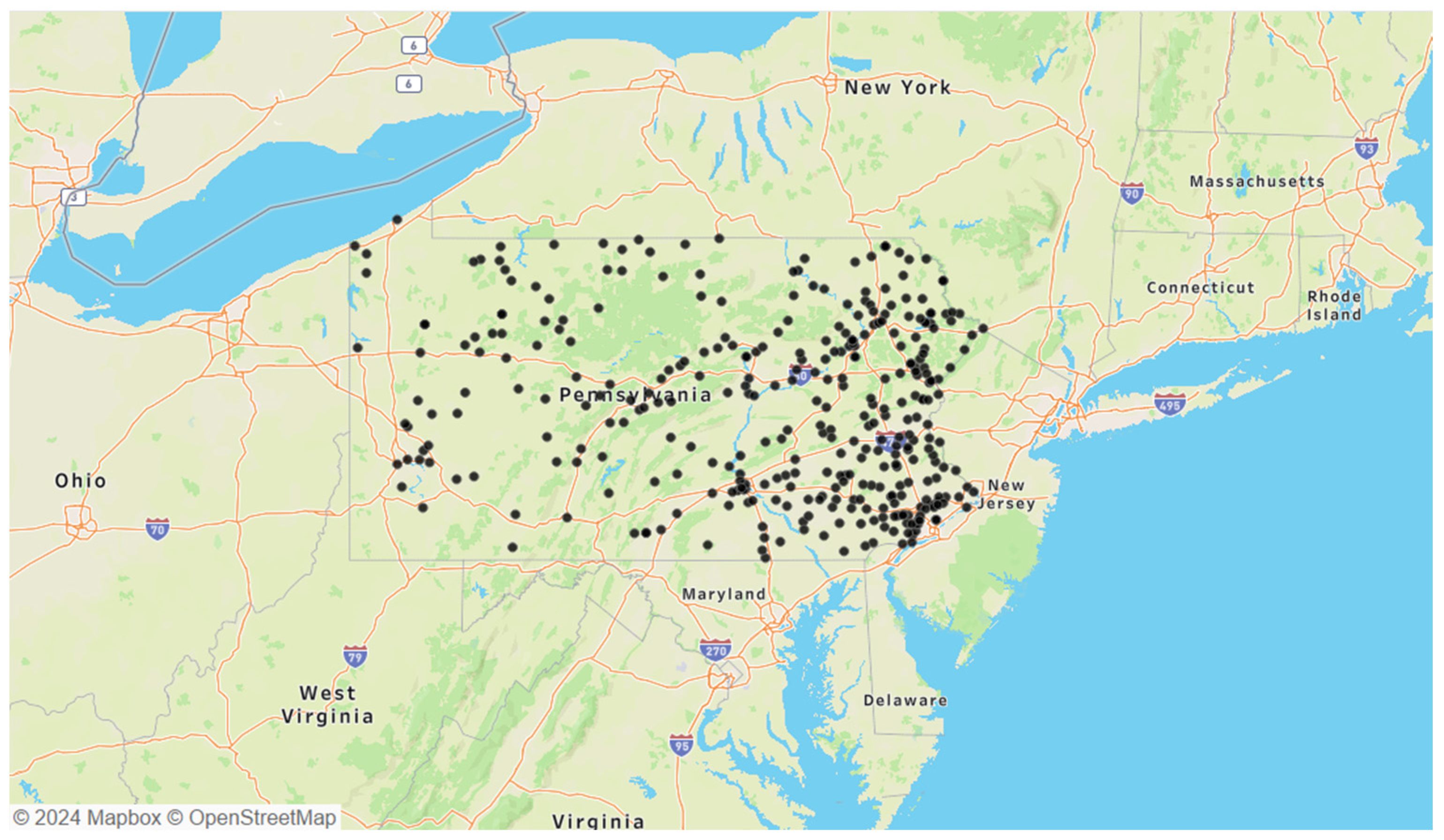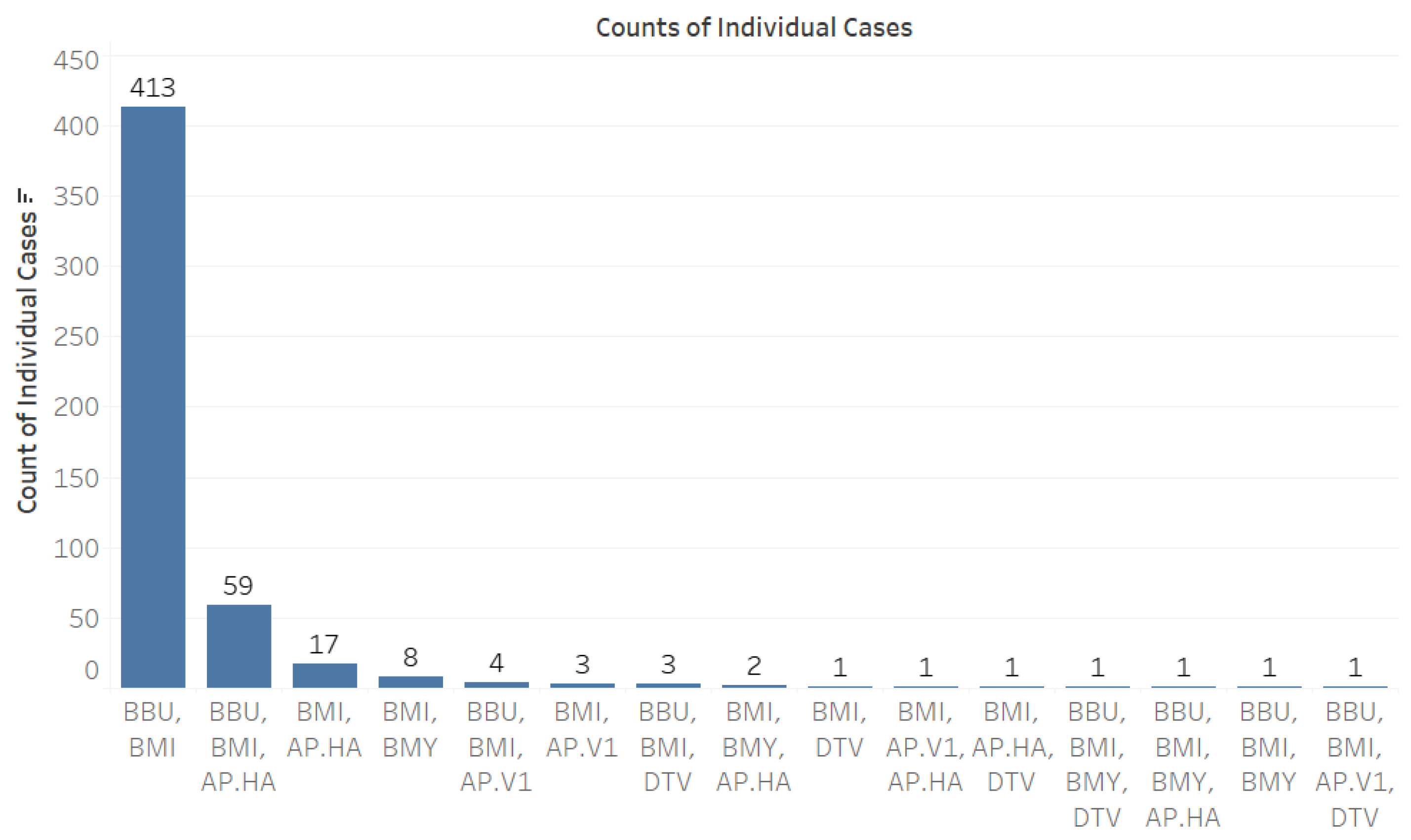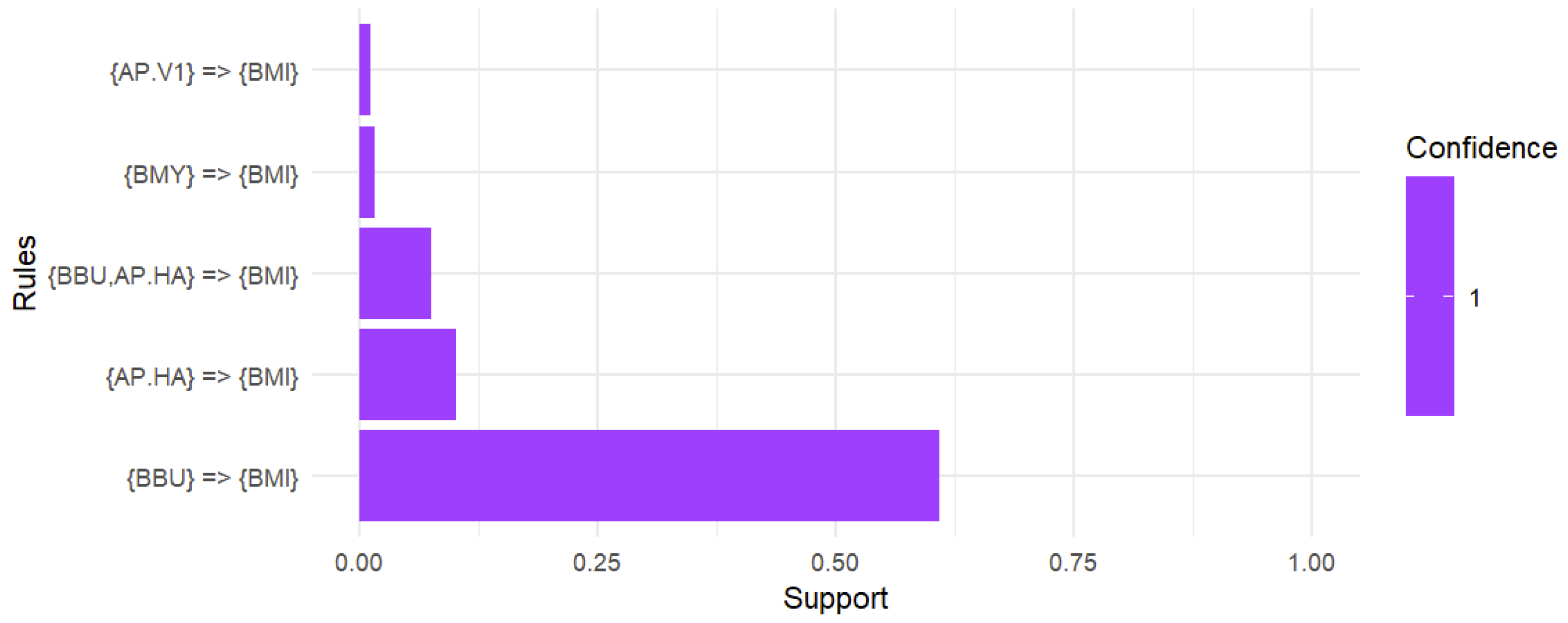Prevalence of Babesia microti Co-Infection with Other Tick-Borne Pathogens in Pennsylvania
Abstract
:1. Introduction
2. Materials and Methods
2.1. Tick Selection
2.2. Pathogen Detection
2.3. Exploratory Data Analysis
3. Results
4. Discussion
5. Conclusions
Supplementary Materials
Author Contributions
Funding
Institutional Review Board Statement
Informed Consent Statement
Data Availability Statement
Acknowledgments
Conflicts of Interest
References
- Waked, R.; Krause, P.J. Human Babesiosis. Infect. Dis. Clin. N. Am. 2022, 36, 655–670. [Google Scholar] [CrossRef] [PubMed]
- Puri, A.; Bajpai, S.; Meredith, S.; Aravind, L.; Krause, P.J.; Kumar, S. Babesia microti: Pathogen Genomics, Genetic Variability, Immunodominant Antigens, and Pathogenesis. Front. Microbiol. 2021, 12, 697669. [Google Scholar] [CrossRef] [PubMed]
- Zimmer, A.J.; Simonsen, K.A. Babesiosis. In StatPearls [Internet]; StatPearls Publishing: Treasure Island, FL, USA, 2024. Available online: https://www.ncbi.nlm.nih.gov/books/NBK430715/ (accessed on 25 October 2024).
- Ingram, D.; Crook, T. Rise in Babesiosis Cases, Pennsylvania, USA, 2005–2018. Emerg. Infect. Dis. 2020, 26, 1703–1709. [Google Scholar] [CrossRef] [PubMed]
- Hersh, M.H.; Ostfeld, R.S.; McHenry, D.J.; Tibbetts, M.; Brunner, J.L.; Killilea, M.E.; LoGiudice, K.; Schmidt, K.A.; Keesing, F. Co-infection of Blacklegged Ticks with Babesia microti and Borrelia burgdorferi is Higher than Expected and Acquired from Small Mammal Hosts. PLoS ONE 2014, 9, e99348. [Google Scholar] [CrossRef] [PubMed]
- Hutchinson, M.L.; Strohecker, M.D.; Simmons, T.W.; Kyle, A.D.; Helwig, M.W. Prevalence Rates of Borrelia burgdorferi (Spirochaetales: Spirochaetaceae), Anaplasma phagocytophilum (Rickettsiales: Anaplasmataceae), and Babesia microti (Piroplasmida: Babesiidae) in Host-Seeking Ixodes scapularis (Acari: Ixodidae) from Pennsylvania. J. Med. Entomol. 2015, 52, 693–698. [Google Scholar] [CrossRef]
- Campagnolo, E.R.; Tewari, D.; Farone, T.S.; Livengood, J.L.; Mason, K.L. Evidence of Powassan/Deer Tick Virus in Adult Black-Legged Ticks (Ixodes scapularis) Recovered from Hunter-Harvested White-Tailed Deer (Odocoileus virginianus) in Pennsylvania: A Public Health Perspective. Zoonoses Public Health 2018, 65, 589–594. [Google Scholar] [CrossRef]
- Edwards, M.J.; Russell, J.C.; Davidson, E.N.; Yanushefski, T.J.; Fleischman, B.L.; Heist, R.O.; Leep-Lazar, J.G.; Stuppi, S.L.; Esposito, R.A.; Suppan, L.M. A 4-Year Survey of the Range of Ticks and Tick-Borne Pathogens in the Lehigh Valley Region of Eastern Pennsylvania. J. Med. Entomol. 2019, 56, 1122–1134. [Google Scholar] [CrossRef]
- Schwartz, S.; Calvente, E.; Rollinson, E.; Sample Koon Koon, D.; Chinnici, N. Tick-Borne Pathogens in Questing Blacklegged Ticks (Acari: Ixodidae) from Pike County, Pennsylvania. J. Med. Entomol. 2022, 59, 1793–1804. [Google Scholar] [CrossRef]
- Kugeler, K.J.; Earley, A.; Mead, P.S.; Hinckley, A.L. Surveillance for Lyme Disease After Implementation of a Revised Case Definition—United States, 2022. MMWR Morb. Mortal. Wkly. Rep. 2024, 73, 118–123. [Google Scholar] [CrossRef]
- Aucott, J.N.; Yang, T.; Yoon, I.; Powell, D.; Geller, S.A.; Rebman, A.W. Risk of post-treatment Lyme disease in patients with ideally-treated early Lyme disease: A prospective cohort study. Int. J. Infect. Dis. 2022, 116, 230–237. [Google Scholar] [CrossRef]
- Eisen, L. Pathogen Transmission in Relation to Duration of Attachment by Ixodes scapularis Ticks. Ticks Tick Borne Dis. 2018, 9, 535–542. [Google Scholar] [CrossRef] [PubMed]
- Madison-Antenucci, S.; Kramer, L.D.; Gebhardt, L.L.; Kauffman, E. Emerging Tick-Borne Diseases. Clin. Microbiol. Rev. 2020, 33, e00083-18. [Google Scholar] [CrossRef] [PubMed]
- Yang, X.; Gao, G.F.; Liu, W.J. Powassan virus: A tick borne flavivirus infecting humans. Biosaf. Health 2022, 4, 30–37. [Google Scholar] [CrossRef]
- Centers for Disease Control and Prevention. Powassan Virus: Current Year Data. 2024. Available online: https://www.cdc.gov/powassan/data-maps/current-year-data.html (accessed on 25 October 2024).
- McCormick, D.W.; Brown, C.M.; Bjork, J.; Cervantes, K.; Esponda-Morrison, B.; Garrett, J.; Kwit, N.; Mathewson, A.; McGinnis, C.; Notarangelo, M.; et al. Characteristics of Hard Tick Relapsing Fever Caused by Borrelia miyamotoi, United States, 2013–2019. Emerg. Infect. Dis. 2023, 29, 1719–1729. [Google Scholar] [CrossRef] [PubMed]
- Eisen, R.J.; Eisen, L. The Blacklegged Tick, Ixodes scapularis: An Increasing Public Health Concern. Trends Parasitol. 2018, 34, 295–309. [Google Scholar] [CrossRef]
- Centers for Disease Control and Prevention. Anaplasmosis: Statistics. Available online: https://www.cdc.gov/anaplasmosis/hcp/statistics/index.html (accessed on 25 October 2024).
- Trost, C.N.; Lindsay, L.R.; Dibernardo, A.; Chilton, N.B. Three Genetically Distinct Clades of Anaplasma phagocytophilum in Ixodes scapularis. Ticks Tick-Borne Dis. 2018, 9, 1518–1527. [Google Scholar] [CrossRef]
- Griffiths, E.C.; Pedersen, A.B.; Fenton, A.; Petchey, O.L. The Nature and Consequences of Coinfection in Humans. J. Infect. 2011, 63, 200–206. [Google Scholar] [CrossRef]
- McArdle, A.J.; Turkova, A.; Cunnington, A.J. When Do Co-Infections Matter? Curr. Opin. Infect. Dis. 2018, 31, 209–215. [Google Scholar] [CrossRef]
- Cox, F.E. Concomitant Infections, Parasites and Immune Responses. Parasitology 2001, 122, S23–S38. [Google Scholar] [CrossRef]
- Supali, T.; Verweij, J.J.; Wiria, A.E.; Djuardi, Y.; Hamid, F.; Kaisar, M.M.M.; Wammes, L.J.; van Lieshout, L.; Luty, A.J.F.; Sartono, E.; et al. Polyparasitism and Its Impact on the Immune System. Int. J. Parasitol. 2010, 40, 1171–1176. [Google Scholar] [CrossRef]
- Birger, R.B.; Kouyos, R.D.; Cohen, T.; Griffiths, E.C.; Huijben, S.; Mina, M.J.; Volkova, V.; Grenfell, B.; Metcalf, C.J.E. The Potential Impact of Coinfection on Antimicrobial Chemotherapy and Drug Resistance. Trends Microbiol. 2015, 23, 537–544. [Google Scholar] [CrossRef] [PubMed]
- Parija, S.C.; Kp, D.; Venugopal, H. Diagnosis and management of human babesiosis. Trop. Parasitol. 2015, 5, 88–93. [Google Scholar] [CrossRef] [PubMed]
- Centers for Disease Control and Prevention. Babesiosis: Clinical Overview. Available online: https://www.cdc.gov/babesiosis/hcp/clinical-overview/index.html (accessed on 25 October 2024).
- Diuk-Wasser, M.A.; Vannier, E.; Hanincová, K.; Healy, S.P.; Finkelstein, I.J.; Brinkerhoff, R.J.; Fitzpatrick, K.A.; Piesman, J. Coinfection by Ixodes Tick-Borne Pathogens: Ecological, Epidemiological, and Clinical Consequences. Trends Parasitol. 2016, 32, 30–42. [Google Scholar] [CrossRef] [PubMed]
- Dunn, J.M.; Krause, P.J.; Davis, S.; Vannier, E.G.; Fitzpatrick, M.C.; Rollend, L.; Belperron, A.A.; States, S.L.; Stacey, A.; Bockenstedt, L.K.; et al. Borrelia burgdorferi promotes the establishment of Babesia microti in the northeastern United States. PLoS ONE 2014, 9, e115494. [Google Scholar] [CrossRef] [PubMed]
- Krakowetz, C.N.; Dibernardo, A.; Lindsay, L.R.; Chilton, N.B. Two Anaplasma phagocytophilum Strains in Ixodes scapularis Ticks, Canada. Emerg. Infect. Dis. 2014, 20, 2064–2067. [Google Scholar] [CrossRef]
- National Center for Emerging and Zoonotic Infectious Diseases (U.S.). Division of Vector-Borne Diseases. Bacterial Diseases Branch. Surveillance for Ixodes scapularis and Pathogens Found in this Tick Species in the United States. 2019. Available online: https://stacks.cdc.gov/view/cdc/78432 (accessed on 25 October 2024).
- Teal, A.E.; Habura, A.; Ennis, J.; Keithly, J.S.; Madison-Antenucci, S. A New Real-Time PCR Assay for Improved Detection of the Parasite Babesia microti. J. Clin. Microbiol. 2012, 50, 903–908. [Google Scholar] [CrossRef]
- Barbour, A.G.; Bunikis, J.; Travinsky, B.; Hoen, A.G.; Diuk-Wasser, M.A.; Fish, D.; Tsao, J.I. Niche Partitioning of Borrelia burgdorferi and Borrelia miyamotoi in the Same Tick Vector and Mammalian Reservoir Species. Am. J. Trop. Med. Hyg. 2009, 81, 1120–1131. [Google Scholar] [CrossRef]
- Courtney, J.W.; Kostelnik, L.M.; Zeidner, N.S.; Massung, R.F. Multiplex Real-Time PCR for Detection of Anaplasma phagocytophilum and Borrelia burgdorferi. J. Clin. Microbiol. 2004, 42, 3164–3168. [Google Scholar] [CrossRef]
- Dupuis II, A.P.; Peters, R.J.; Prusinski, M.A.; Falco, R.C.; Ostfeld, R.S.; Kramer, L.D. Isolation of Deer Tick Virus (Powassan Virus, Lineage II) from Ixodes scapularis and Detection of Antibody in Vertebrate Hosts Sampled in the Hudson Valley, New York State. Parasites Vectors 2013, 6, 185. [Google Scholar] [CrossRef]
- Volk, M. The Effect of Broad-Scale Climate and Microclimate Conditions on Ixodes scapularis (Acari: Ixodidae) Overwintering Survival and Distribution in Maine. Master’s Thesis, University of Maine, Orano, ME, USA, 2020; p. 3316. [Google Scholar]
- Hahsler, M.; Grün, B.; Hornik, K. Arules—A Computational Environment for Mining Association Rules and Frequent Item Sets. J. Stat. Softw. 2005, 14, 1–25. [Google Scholar] [CrossRef]
- Nordmann, E.; McAleer, P.; Toivo, W.; Paterson, H.; DeBruine, L.M. Data Visualization Using R for Researchers Who Do Not Use R. Adv. Methods Pract. Psychol. Sci. 2022, 5, 2. [Google Scholar] [CrossRef]
- Tufts, D.M.; Diuk-Wasser, M.A. Vertical transmission: A vector-independent transmission pathway of Babesia microti in the natural reservoir host Peromyscus leucopus. J. Infect. Dis. 2021, 223, 1787–1795. [Google Scholar] [CrossRef] [PubMed]
- Lehane, A.; Maes, S.E.; Graham, C.B.; Jones, E.; Delorey, M.; Eisen, R.J. Prevalence of single and coinfections of human pathogens in Ixodes ticks from five geographical regions in the United States, 2013–2019. Ticks Tick Borne Dis 2021, 12, 101637. [Google Scholar] [CrossRef] [PubMed]
- Knapp, K.L.; Rice, N.A. Human Coinfection with Borrelia burgdorferi and Babesia microti in the United States. J. Parasitol. Res. 2015, 2015, 587131. [Google Scholar] [CrossRef] [PubMed]
- Centers for Disease Control and Prevention. Powassan Virus: Historic Data. Available online: https://www.cdc.gov/powassan/data-maps/historic-data.html (accessed on 25 October 2024).
- Vannier, E.; Richer, L.M.; Dinh, D.M.; Brisson, D.; Ostfeld, R.S.; Gomes-Solecki, M. Deployment of a Reservoir-Targeted Vaccine Against Borrelia burgdorferi Reduces the Prevalence of Babesia microti Coinfection in Ixodes scapularis Ticks. J. Infect. Dis. 2023, 227, 1127–1131. [Google Scholar] [CrossRef]
- Burde, J.; Bloch, E.M.; Kelly, J.R.; Krause, P.J. Human Borrelia miyamotoi infection in North America. Pathogens 2023, 12, 553. [Google Scholar] [CrossRef]
- Wormser, G.P.; Dattwyler, R.J.; Shapiro, E.D.; Halperin, J.J.; Steere, A.C.; Klempner, M.S.; Krause, P.J.; Bakken, J.S.; Strle, F.; Stanek, G.; et al. The Clinical Assessment, Treatment, and Prevention of Lyme Disease, Human Granulocytic Anaplasmosis, and Babesiosis: Clinical Practice Guidelines by the Infectious Diseases Society of America. Clin. Infect. Dis. 2006, 43, 1089–1134. [Google Scholar] [CrossRef]
- Murray, J.; Cohen, A.L. Infectious Disease Surveillance. In International Encyclopedia of Public Health; Academic Press: New York, NY, USA, 2017; pp. 222–229. [Google Scholar] [CrossRef]
- Gilbert, R.; Cliffe, S.J. Public Health Surveillance. In Public Health Intelligence: Issues of Measure and Method; Springer International Publishing: Cham, Switzerland, 2016; pp. 91–110. [Google Scholar] [CrossRef]
- Commonwealth of Pennsylvania-Tick-Borne Diseases. Available online: https://www.pa.gov/en/agencies/health/diseases-conditions/infectious-disease/vectorborne-diseases/tick-diseases.html#accordion-377c1933bb-item-91f989e7d2 (accessed on 23 September 2024).
- Spichler-Moffarah, A.; Ong, E.; O’Bryan, J.; Krause, P.J. Cardiac Complications of Human Babesiosis. Clin. Infect. Dis. 2023, 76, e1385–e1391. [Google Scholar] [CrossRef]
- Grant, L.; Mohamedy, I.; Loertscher, L. One Man, Three Tick-Borne Illnesses. BMJ Case Rep. 2021, 14, e241004. [Google Scholar] [CrossRef]
- Krause, P.J.; McKay, K.; Thompson, C.A.; Sikand, V.K.; Lentz, R.; Lepore, T.; Closter, L.; Christianson, D.; Telford, S.R.; Persing, D.; et al. Deer-Associated Infection Study Group. Disease-specific diagnosis of coinfecting tick-borne zoonoses: Babesiosis, human granulocytic ehrlichiosis, and Lyme disease. Clin. Infect. Dis. 2002, 34, 1184–1191. [Google Scholar] [CrossRef]
- Koetsveld, J.; Platonov, A.E.; Kuleshov, K.; Wagemakers, A.; Hoornstra, D.; Ang, W.; Szekeres, S.; van Duijvendijk, G.L.A.; Fikrig, E.; Embers, M.E.; et al. Borrelia miyamotoi infection leads to cross-reactive antibodies to the C6 peptide in mice and men. Clin. Microbiol. Infect. 2020, 26, 513.e1–513.e6. [Google Scholar] [CrossRef] [PubMed]





| Species | Gene | Primer Sequence | Probe Sequence | Source |
|---|---|---|---|---|
| Babesia microti | 18s rRNA | F—CAGGGAGGTAGTGACAAGAAATAACA R—GGTTTAGATTCCCATCATTCCAAT | VIC—TACAGGGCTTAAAGTCT—MGBNFQ | [31] |
| Borrelia burgdorferi | 16s-23S | F—GCTGTAAACGATGCACACTTGGT R—GGCGGCACACTTAACACGTTAG | 6FAM—TTCGGTACTAACTTTTAGTTAA—MGBNFQ | [32] |
| Borrelia miyamotoi | 16s-23S | F—GCTGTAAACGATGCACACTTGGT R—GGCGGCACACTTAACACGTTAG | ABY—CGGTACTAACCTTTCGATTA—QSY | [32] |
| Anaplasma phagocytophilum | Msp2 | F—ATGGAAGGTAGTGTTGGTTATGGTATT R—TTGGTCTTGAAGCGCTCGTA | ABY—TGGTGCCAGGGTTGAGCTTGAGATTG—QSY | [33] |
| Anaplasma phagocytophilum variants | 16s rRNA | F—ACATGCAAGTCGAACGGATTATTCT R—GCTATCCCATACTACTAGGTAGATTCCT | (Ap-ha) VIC—CTGCCACTAACTATTCT—MGB (Ap-v1) FAM—CTGCCACTAATTATTCT—MGB | [29] |
| * Powassan virus lineage I and II | NS5 | F—CATAGCAAAGGTGAGATCCAA R-TCGCTGAGCTCCATTTATT | [34] | |
| * Powassan lineage I | NS5 | F—CATAGCGAAGGTGAGGTCCAA R-TTGCCGAGCTCCACTTGTT | QSY-CGCTTGGTCGGATGAACA-6FAM | [34] |
| Deer tick virus (Powassan lineage II) | NS5 | F—GATCATGAGAGCGGTGAGTGACT R—GGATCTCACCTTTGCTATGAATTCA | BHQ-TGAGCACCTTCACAGCCGAGCCAG-6FAM | [34] |
| Ixodidae positive control | 16s rRNA | F—AATACTCTAGGGATAACAGCGTAATAATTTT R—CGGTCTGAACTCAGATCAAGTAGGA | 6FAM—AATAGTTTGCGACCTCGATGTTGGATTAGGAT-QSY | [35] |
Disclaimer/Publisher’s Note: The statements, opinions and data contained in all publications are solely those of the individual author(s) and contributor(s) and not of MDPI and/or the editor(s). MDPI and/or the editor(s) disclaim responsibility for any injury to people or property resulting from any ideas, methods, instructions or products referred to in the content. |
© 2024 by the authors. Licensee MDPI, Basel, Switzerland. This article is an open access article distributed under the terms and conditions of the Creative Commons Attribution (CC BY) license (https://creativecommons.org/licenses/by/4.0/).
Share and Cite
Nijjar, L.S.; Schwartz, S.; Koon Koon, D.S.; Marin, S.M.; Jimenez, M.E.; Williams, T.; Chinnici, N. Prevalence of Babesia microti Co-Infection with Other Tick-Borne Pathogens in Pennsylvania. Microorganisms 2024, 12, 2220. https://doi.org/10.3390/microorganisms12112220
Nijjar LS, Schwartz S, Koon Koon DS, Marin SM, Jimenez ME, Williams T, Chinnici N. Prevalence of Babesia microti Co-Infection with Other Tick-Borne Pathogens in Pennsylvania. Microorganisms. 2024; 12(11):2220. https://doi.org/10.3390/microorganisms12112220
Chicago/Turabian StyleNijjar, Lovepreet S., Sarah Schwartz, Destiny Sample Koon Koon, Samantha M. Marin, Mollie E. Jimenez, Trevor Williams, and Nicole Chinnici. 2024. "Prevalence of Babesia microti Co-Infection with Other Tick-Borne Pathogens in Pennsylvania" Microorganisms 12, no. 11: 2220. https://doi.org/10.3390/microorganisms12112220
APA StyleNijjar, L. S., Schwartz, S., Koon Koon, D. S., Marin, S. M., Jimenez, M. E., Williams, T., & Chinnici, N. (2024). Prevalence of Babesia microti Co-Infection with Other Tick-Borne Pathogens in Pennsylvania. Microorganisms, 12(11), 2220. https://doi.org/10.3390/microorganisms12112220









